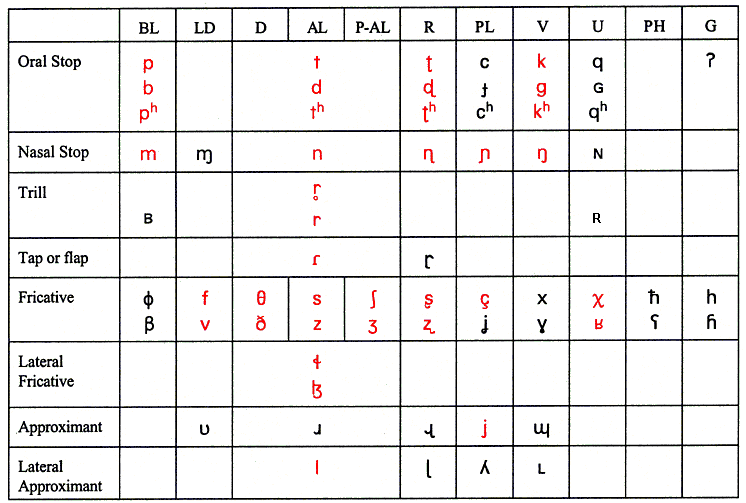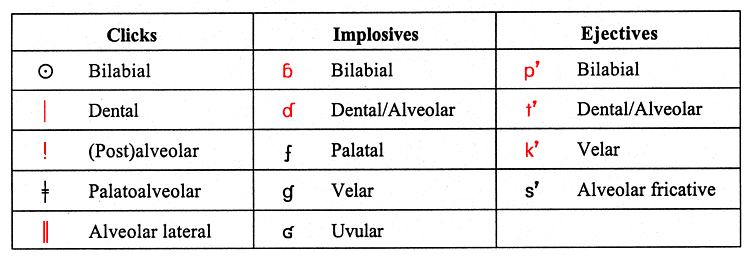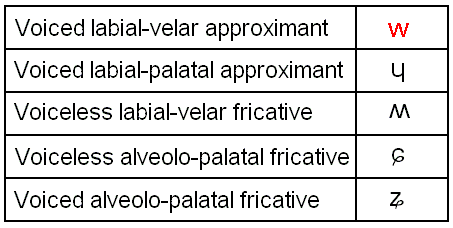IPA Consonant Symbols - Pulmonic Consonants
| Important: You must have installed the phonetic font "Charis SIL" or tested this installation to determine if the phonetic characters installed properly. |
International Phonetic Alphabet
(Revised to 2005)
IPA Consonant Symbols
Pulmonic Consonants
Pulmonic consonants are consonants that depend upon an egressive (outward-flowing) air stream originating in the lungs. For more details on pulmonic consonant airstream characteristics see the topic on " Airstream and laryngeal features in speech production".
The following table contains all of the single-articulation pulmonic consonants listed in the International Phonetic Alphabet (revised to 2005). The aspirated stops and the voiceless alveolar trill don't actually belong in this table as they are combinations of existing consonant symbols plus diacritics.
The column titles are abbreviations of the place of articulation of the consonants in that column. For a key to the place-of-articulation abbreviations, see the table immediately below this table. For more information on consonant place of articulation, see the topic Consonants.
The row titles indicate the manner of articulation of the sounds in that row. For more information on consonant manner of articulation, see the topic Consonants.
In this table, whenever two symbols appear in the same cell, the upper symbol is voiceless and the lower symbol is voiced. For more detailed information on voicing in consonants see the topic on "Airstream and laryngeal features in speech production".
The third symbol in the oral stop cells is the voiceless aspirated stop. For information on voicing and aspiration in oral stops (voice onset time), see the topic on Airstream and Laryngeal Features in Speech Production.

| Recorded examples (CV context with a following [ɐ] vowel) have been supplied for each of the symbols in red. CLICK ON THE RED SYMBOLS TO HEAR THE EXAMPLE . |
Table of Place of Articulation Codes used in the pulmonic consonant table (above)
| BL | Bilabial | PL | Palatal |
| LD | Labiodental | V | Velar |
| D | Dental | U | Uvular |
| AL | Alveolar | PH | Pharyngeal |
| P-AL | Post-alveolar (see note 1) | G | Glottal |
| R | Retroflex (see note 2) |
Notes:
1) Note that the post-alveolar fricative symbols [ʃ] and [ʒ] are sometimes referred to in the literature as "palato-alveolar" fricatives. This implies a primary alveolar fricative articulation with a secondary palatal approximant articulation. The term "post-alveolar" implies a single fricative articulation just behind the alveolar ridge. For this course the term "post-alveolar" is preferred. For more information on complex articulations and primary and secondary articulations see the topic Complex Articulations.
2) The retroflex sounds are sometimes referred to as "post-alveolar". Retroflex sounds can be post-alveolar or palatal, but they are distinguished from those sounds in their use of the tongue tip as the active articulator (that is they are "apico-" articulations). The tip of the tongue curls back towards these places of articulation. The post-alveolar consonants use the blade of the tongue ("lamino-") whilst the palatal consonants use the front of the tongue. For more information on active and passive articulators see the topic Consonants. For more information on the parts of the tongue see the diagram Vocal Tract Articulators in the topic Consonants.
Non-Pulmonic Consonants
These non-pulmonic consonants don't use pulmonic airflow. Instead they use velaric airflow (clicks) or glottalic airflow (implosives and ejectives). For more detailed information on non-pulmonic consonants see the topic on " Airstream and laryngeal features in speech production".

| Recorded examples (CV context with a following [ɐ] vowel) have been supplied for each of the symbols in red. CLICK ON THE RED SYMBOLS TO HEAR THE EXAMPLE . |
Complex Articulations
The following table is a list of some of the complex consonants that have either double articulation (both places of articulation with the same degree of stricture) or secondary articulation (a primary articulation coupled with a secondary articulation with a lesser degree of stricture) that also have their own single IPA symbol. For more information on stricture see the topic Consonants.
Most other double articulations are represented by two IPA symbols tied together by a ligature (for example k͡p for a double bilabial-velar stop). Most other secondary articulations are indicated by the addition of a diacritic to the symbol for the primary articulation (for example dˠ for a voiced velarised alveolar stop). For more information, see the topic on Complex Articulations.
In the following table, [w] is the lip-rounded counterpart of the approximant [ɰ] and [ɥ] is the lip-rounded counterpart of the approximant [j]. Note that the labial-velar and labial-palatal approximants are not "labialised" as both the labial articulation and the velar or palatal articulation have approximant stricture. (This is also true for [ʍ] except that the two articulations have fricative stricture.) Since both articulations have the same stricture these sounds are double articulations and so take the place-of-articulation labels "labial-velar" and "labial-palatal".
The last two symbols on this table have a primary palatal articulation with fricative stricture and a secondary alveolar articulation with approximant stricture (note, however, that usage of these two symbols varies in the literature and they are sometimes confused with [ʃ] and [ʒ]).

| Recorded examples (CV context with a following [ɐ] vowel) have been supplied for each of the symbols in red. CLICK ON THE RED SYMBOLS TO HEAR THE EXAMPLE . |
Content owner: Department of Linguistics Last updated: 12 Mar 2024 9:53am
